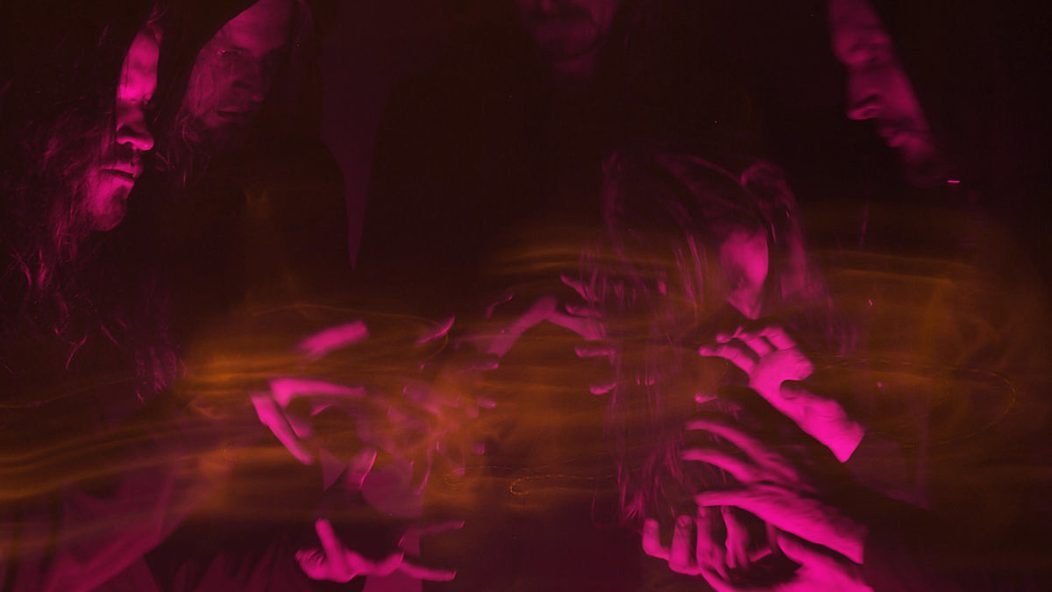
So Grim So True So Real: Oranssi Pazuzu

…
So Grim, So True, So Real offers a new way to think about a given band’s discography. In this feature, we will first highlight the low point in a band’s body of work (So Grim), and then the album which, to the best of the IO team’s estimation, most people hold in the greatest esteem (So True), and finally one album which holds up as the best listening experience, regardless of what fans and critics insist (So Real).
…
The three e’s of Finnish band Oranssi Pazuzu: eclectic, eccentric, enchanting. Now a decade on, they’ve traversed leagues of experimental and psychedelic territory (while always hovering near to black metal) over four full-length albums. Each release has distinct character and a distinctive brand of esotericism, yet they connect like a chain of evolutionary ancestors. Exploring earlier works only augments the enjoyment of revisiting later albums, and vice versa. To wit, great bands always get better the deeper you delve.
Relatedly, Oranssi Pazuzu have employed a wide variety of influences and methodologies to achieve their honed but always atmospheric sound.. From krautrock co-founders Amon Düül II to French progressive rock (more specifically, Zeuhl) band Magma, the band’s fingers and toes are permanently dipped in 1970’s-era expressions of avant-garde and anti-traditional inclinations. Beyond sheer experimentation, though, comes Oranssi Pazuzu’s fluency in incorporating these influences into overtly metal constructions. While some multidimensional metal bands branch out never to return, this one in particular remained metal to the core, uncovering the metal inherent in non-metal rather than simply reconstructing something metal from otherwise non-metal parts.
This all sounds very positive — and it is — meaning the “so grim” of the situation is the hardest to pinpoint. Leave it at this: the worst part about Oranssi Pazuzu is that there isn’t more Oranssi Pazuzu to listen to. That said, there’s one album in particular which seems, just ever so slightly, to be edged out by its siblings. It’s still a great experimental metal album in its own right for sure, but it didn’t coalesce as the “full-on” Oranssi Pazuzu experience as well as their others (though it does have some pretty spectacular moments).
…
So Grim
Valonielu (2013)
Pazuzu had revamped and completely modernized their feel with Valonielu, introducing heavier synth and more industrial riffing, simultaneously to the band’s benefit and detriment. Catchiness, oddly enough, became a revitalized tool to draw listeners into ethereal details embedded into more standard-fare Oranssi Pazuzu krautrock-based progressions. It’s not that Valonielu has the darkest mood of the bunch, but perhaps the most aggressive one. Newly toying with steeper ascents (and deeper descents) lent the band a more turbulent wavelength of intensity which may not have been to every fan’s liking.
To its benefit, though, Valonielu did recapture the straightforward metal from Muukalainen Puhuu, but modernized it significantly. Downtempo and downtuned, Oranssi Pazuzu had begun hammering on key “groove” moments and chords right to the point of breakage, then dissolving them into abstract soundscapes only to return to a new, even catchier line. On this album specifically, they perfected the thematic modulation of atmosphere to achieve their characteristic wary, freaky soundscapes; the oddball track “Reikä Maisemassa,” for example, reverberates horror and noir to generate its atmosphere.
This album also saw Oranssi Pazuzu dabbling with noise-walls — albeit not as adeptly as on Värähtelijä — focusing on texture instead of minute detail, especially on the penultimate track “Olen Aukaissut Uuden Silmän.” They exercise cautious restraint, though, recognizing that movements toward the postmodern add a certain aesthetic “flatness” which could sully the all-important element of intricacy. This restraint works, actually, but perhaps too well, as Valonielu finds itself right at the cusp of something more groundbreaking and evocative.
…
So True
Värähtelijä (2016)
In a career-defining move, Pazuzu wrote Värähtelijä with the energy of Muukalainen Puhuu, the abstraction of Kosmonument, and the groove of Valonielu. But brand new were overarching senses of ambition and courage, and with that, a decisively postmodern will for experimentation. Laid over their heaviest framework to date, Pazuzu took chances and went full “wall-of-sound,” using detail and intricacy in service of texture, not the other way around. Though not without its concrete moments, Värähtelijä seeks pure psychedelic bliss and finds it amid the color splotches and obtuse geometry of a profound inward vision. As stimulating and dissociative as it is, this album is fundamentally meditative.
If you strip “psychedelic” from its druggy connotations, you get Värähtelijä‘s essential character. This allows Oranssi Pazuzu’s signature “unsettling” effect to live neutrally — neither positive nor negative — amid the expansiveness of Värähtelijä‘s experimental tendencies. The band increased headroom by allowing for more noise, more volume, and therefore more impact: Värähtelijä is their most forcibly intense in this regard. There’s an important duality, though: an equal amplification of the album’s abstract and more introspective moments. Pazuzu discovered how to draw out beats and samples over long rhythmic stretches, continuously varied among background noises, to achieve wavering/trance-like moments which offset heavy-hitting material. The track “Vasemman Käden Hierarkia” is particularly microcosmic in this regard.
Värähtelijä does not brashly challenge listeners, and perhaps that helps explain its broader appeal: gaining access to its ethereal landscape doesn’t require patience, but rather openness. The vibe-filled grooves at the music’s core — an evolution beyond the surf-rock beats — carry themselves over from Valonielu but are completely revamped through a surreal new lens. We already knew that Oranssi Pazuzu was an innovative band, yet this album was innovative even for them: not just something fresh, interesting, or different, but something “from the beyond.”
…
So Real
Muukalainen Puhuu (2009)
In retrospect, Pazuzu’s first full-length Muukalainen Puhuu is a “safe bet” release, laying the impermeable groundwork for the hypnotic brand of transcendental music which became their callsign. Pazuzu’s dramatic switchbacks between eerie surf-rock beats and blackened, blast beat-laden passages on Muukalainen Puhuu established a wide, ethereal breadth. To that end, the never-clean vocals, especially juxtaposed with slow rock-based drumming, deepened Oranssi Pazuzu into purely experimental territory where innovation, not combination, is the key to survival. The band would later blossom this multi-genre approach to essentially overcome not only their own limitations/struggles, but those of black metal as well.
Muukalainen Puhuu‘s longest and strongest track “Dub Kuolleen Porton Muistolle” contains the restrained but dizzying energy characteristic to all subsequent Oranssi Pazuzu. Carried on catchy bass lines, both cosmic synth and noodly guitars intertwine for a multifaceted atmosphere, foregoing the traditional wall-of-noise approach and substituting something much more meticulous. If this album was an unlicensed medical procedure, it’d be a direct-contact brain massage, with prods and pricks to important cortical areas associated with sight and corporeal sensation. The idea being to induce surreality without mood-ruining nausea, Pazuzu had discovered that the alt-ness of krautrock and chill vibe of surf-rock could be carefully amalgamated into headspacey metal.
All the while, a foray into ambient and abstract soundscapes on Muukalainen Puhuu (like the penultimate track “Muukalainen Puhuu”) reinforced the frightening, arthouse atmosphere critical to Pazuzu’s appeal. While the sometimes upbeat/poppy pretensions of their influences were lost in translation, Pazuzu manages an overall playfulness amidst unsettling seriousness. That’s to say Muukalainen Puhuu is fun, not in terms of sheer entertainment, but in terms of new and experiential passageways through already-familiar beats. To the band’s benefit, keeping the listener’s mind on autopilot with recognizable and relatable drumming frees up mental resources to absorb all kinds of overlaying atmospheric eccentricities. This discovery carried forward for their entire career (and was expounded upon finally and most dramatically on Värähtelijä).
Oranssi Pazuzu became increasingly atmospheric over the years, though they wouldn’t have landed on success without having evolved this atmosphere from the throwback, in-house experimental vibes which characterize Muukalainen Puhuu. Their ability to derive spacy, mental detachment from otherwise grounded roots demonstrates the extent to which the band could manipulate, through layering and composition, any given riff or beat. Muukalainen Puhuu celebrates the authenticity of Oranssi Pazuzu’s influences while also showcasing how elaborate the band could be in twisting them for psychedelic effect. Ultimately, this band showed us with their very first release that experimentation goes beyond the simple repurposing of otherwise unrelated musical elements and genres: to experiment, one must find a special synergy where there was once none.
…







